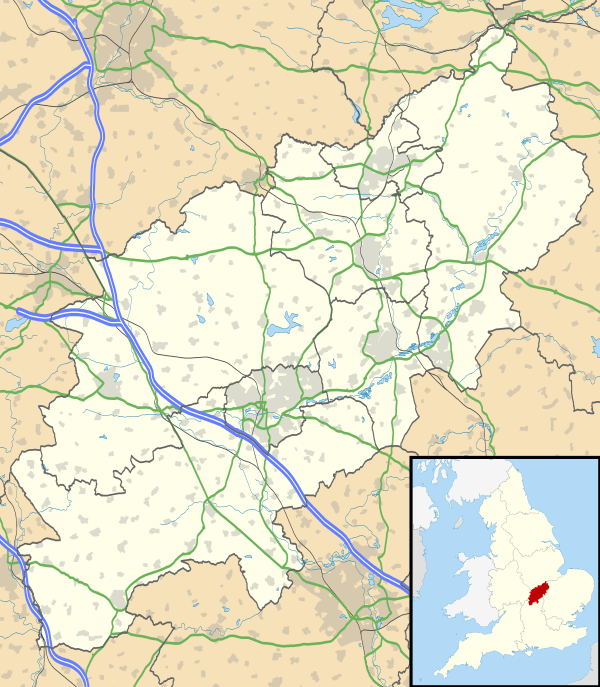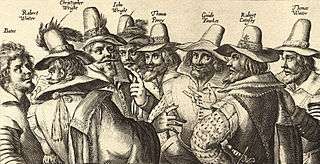Ashby St Ledgers
| Ashby St Ledgers | |
 The manor house where the Gunpowder plot was planned |
|
 Ashby St Ledgers |
|
| Population | 173 (2011 Census) |
|---|---|
| OS grid reference | SP5768 |
| – London | 78 miles (126 km) |
| District | Daventry |
| Shire county | Northamptonshire |
| Region | East Midlands |
| Country | England |
| Sovereign state | United Kingdom |
| Post town | RUGBY |
| Postcode district | CV23 8 |
| Dialling code | 01788 |
| Police | Northamptonshire |
| Fire | Northamptonshire |
| Ambulance | East Midlands |
| EU Parliament | East Midlands |
| UK Parliament | Daventry |
|
|
Coordinates: 52°18′N 1°10′W / 52.30°N 01.16°W
Ashby St Ledgers is a village in the Daventry district of Northamptonshire, England.[1] The post town is Rugby in Warwickshire. The population of the civil parish at the 2011 census was173.[2] The Manor House is famous for being a location for the planning of the Gunpowder Plot in 1605.[3]
Location
The nearest large towns are Rugby, 5 miles (8.0 km) north west, and Daventry, 3 miles (4.8 km) south. The A5 road), the Roman road Watling Street passes about a mile east. Rugby has the nearest railway station on the West Coast Main Line with trains to London Euston and several other parts of the country. It is about 5 miles (8.0 km) north via th A5 to the M1 London to Yorkshire motorway junction 18 and bout 7 miles (11.3 km) south to junction 16.
History
Ashby St Ledgers was first mentioned in the Domesday Book, which gave the place name as Ascebi ("ash tree settlement"). In Norman times, a church was erected on the site, dedicated to Saint Leodegarius, from whom the modern-day name is derived.
Notable buildings
Manor House
The manor was given as a gift to Hugh de Grandmesnil by William the Conqueror and passed to various other occupants until 1375 when it passed into the Catesby family, and became their principal residence.
The manor was briefly confiscated after the attainder and execution of William Catesby, one of Richard III's counsellors, after losing the Battle of Bosworth in 1485, but was later returned to his son, George. It passed down the male line to Robert Catesby's father, Sir William Catesby, who managed to hold on to the property in spite of massive debts caused by recusancy fines and years of imprisonment for his stubborn adherence to the Roman Catholic faith.

- ^ The Gunpowder Plot Conspirators, Crispiijn van de Passe, National Portrait Gallery, accessed 12 March 2010
The manor's central location was also more convenient to the houses of the Catesby's many friends and relations. It is this central location that made Ashby St Ledgers a type of 'Command Centre' during the planning of the Gunpowder Plot.
It was here, in the room above the Gatehouse, with its privacy from the main house and clear view of the surrounding area, that Robert Catesby, his servant Thomas Bates and the other conspirators planned a great deal of the Gunpowder Plot. Catesby was killed at Holbeche House whereas his servant was executed in the following January.
Following Catesby's death in 1605, the manor was confiscated by the crown as the property of a traitor. In 1612, it was purchased by Bryan I'Anson (1560-1634), Sheriff of the City of London.[4] He was the father of Sir Bryan I'Anson, 1st Bt., of Ashby St Ledgers; Gentleman of the Bedchamber to Charles I of England.[5] In 1703, Esther I'Anson (Sir Bryan's elder brother John's great-granddaughter) sold the manor to Joseph Ashley, a London draper. When his great nephew, also called Joseph Ashley, died in 1798, the manor was passed to his daughter, Mary, who was the wife of Sir Joseph Senhouse. Their daughter, Elizabeth, married Joseph Pocklington in 1835, and the manor remained in their family until 1903, when it was sold to Ivor Guest, 1st Viscount Wimborne.[4]
Until recently the house suffered from decay and neglect, in need of restoration. The former owner*, Lord Wimborne, estimated it would need about £10 million to save it for future generations.[6] In 2005, The Crown Estate bought the Ashby St Ledgers estate (minus the Manor House) .[6] It will continue to be run as an agricultural business, but run by its Rural Directorate.
The sale of the 2,337-acre (9.46 km2) Ashby St Ledgers estate did not include The Manor House. The land was put up for sale in July 2005 on behalf of the Baker brothers, a family which has owned the grounds since 1982, having purchased it from the British Airways Pension Fund. The site includes an organic dairy farm, a country sports centre and Chapel Farm, which 150 years ago was the home of Thomas Arnold, the headmaster of Rugby School. The Manor was sold off separately by British Airways and passed through a succession of speculative owners until it was eventually purchased in 1998 by former owner Viscount Wimborne's grandson and namesake, Ivor Guest, 3rd Viscount Wimborne, in an attempt to save the Manor House from total ruin. The ownership of the Manor and its gardens, as far as is known, remains with Lord Wimborne.
Other buildings
The church is dedicated to Saint Leodegarius and has wall paintings showing the Passion of Christ ca.1500, with 18 scenes, and the flagellation of St Margaret ca.1325.[7]
The village has a pub, the Olde Coach House Inn.
References
- ↑ OS Explorer Map Map 223 - Northampton & Market Harborough (1:25 000) ISBN 0 319 23735 4
- ↑ "Civil Parish population 2011". Neighbourhood Statistics. Office for National Statistics. Retrieved 27 June 2016.
- ↑ History of Ashby St Ledgers - The Gunpowder Plot Society Archived 8 July 2006 at the Wayback Machine.
- 1 2 The Middle Class (2010), Lawrence James
- ↑ History of the I'Anson family of Ashby St Ledgers
- 1 2 Queen buys estate - BBC
- ↑ Pevsner, Nikolaus (1961). The Buildings of England – Northamptonshire - has a picture of the MIldmay monument and church wall paintings. London and New Haven: Yale University Press. pp. 89–93. ISBN 978-0-300-09632-3.
External links
| Wikimedia Commons has media related to Ashby St Ledgers. |
- Ashby [St Ledgers] in the Domesday Book
